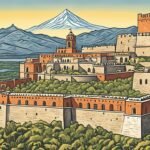Have you ever thought about what’s hidden under an old civilization? Get ready for an exciting journey as we reveal the secrets of the Cholula Great Pyramid. It’s the biggest pyramid in the world by size. Located in Mexico, it has fascinated historians, archaeologists, and travelers for years. What secrets does this huge monument hold?
Key Takeaways
- The Cholula Great Pyramid is the largest pyramid in the world by volume, measuring an astounding 4.45 million cubic meters.
- Construction of the pyramid began around the 3rd century BCE and continued through the pre-Columbian era, spanning several centuries.
- Archaeologists have uncovered a wealth of artifacts, including pottery shards, murals, and symbolic relics, providing insights into the ancient cultures that shaped this colossal structure.
- The pyramid remained hidden for centuries, preserved by a natural disguise of vegetation until its rediscovery in the early 20th century.
- Visitors can explore the accessible sections of the pyramid, offering close-up experiences and breathtaking panoramic views of this enigmatic marvel.
Uncovering Cholula’s Colossal Secret
The World’s Largest Pyramid Lies Hidden
In the Mexican town of San Andrés Cholula, a huge structure awaits. It’s the world’s biggest pyramid by volume. This pyramid is not just one big structure. It shows how different cultures worked together over many centuries.
It started with the Olmecs or Toltecs, and the Aztecs later added to it. This pyramid is a wonder of engineering and history. It shows the deep culture of the area.
| Fact | Statistic |
|---|---|
| Height of the Great Pyramid of Cholula | 216 feet (66 meters) |
| Base Dimensions of the Pyramid | 450 by 450 meters (1,480 by 1,480 feet) |
| Total Volume of the Pyramid | Over 4.45 million cubic meters |
| Equivalent Volume to Olympic-Sized Swimming Pools | 9 pools |
| Construction Period | 3rd century BCE to 9th century AD |
The Cholula Great Pyramid is amazing in size and design. It covers 45 acres and has 7 pyramids and 6 layers. Each layer tells of the cultures that built it. This largest pyramid base in the world shows the skill and hard work of pre-Columbian people.
Layers of History: A Monument Through Time
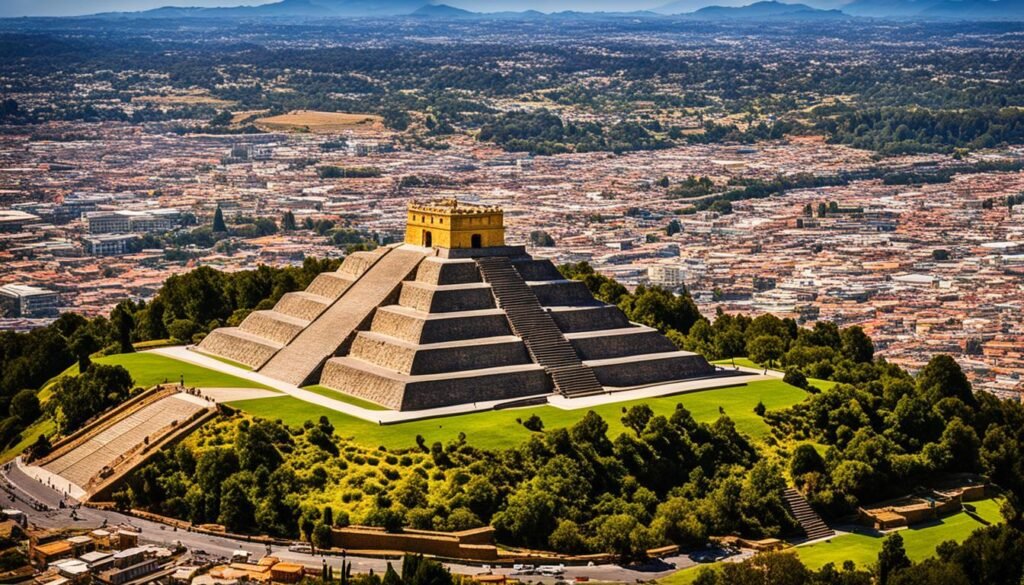
The Cholula Great Pyramid is a true marvel. It shows the rich history of Mesoamerican civilizations over the centuries. This huge structure is more than just a sign of great architecture. It tells us about the cultural changes, beliefs, and rituals of the people who lived here.
It was built in four distinct phases over a thousand years, from the 3rd century BC to the 9th century AD. The Cholula Great Pyramid is a symbol of the lasting impact of Pre-Columbian architecture and Aztec culture. Each layer of the pyramid tells us about the people who worked hard to build it. They honored the god Quetzalcoatl with their dedication.
At its peak, the Cholula Great Pyramid was home to about 100,000 people. It was a busy center of Mesoamerican life. Its size was even bigger than the Great Pyramid of Giza. This shows the skill and hard work of its builders who faced many challenges.
The Cholula Great Pyramid is a lasting reminder of the civilizations that shaped this land. Every layer and detail tells us about the culture here over the centuries. It invites us to explore, discover, and admire the resilience and creativity of people.
| Key Facts about the Cholula Great Pyramid |
|---|
| – The largest pyramid (by volume) in the world, with over 4.45 million cubic meters |
| – Built in four stages from the 3rd century BC to the 9th century AD |
| – Dedicated to the deity Quetzalcoatl |
| – Estimated to have had a population of 100,000 at its peak |
| – Features talud-tablero architecture associated with Teotihuacan |
| – Underwent multiple construction phases over a thousand years |
| – Larger in base dimensions than the Great Pyramid of Giza |
The Cholula Great Pyramid: Ancient Marvel Unveiled
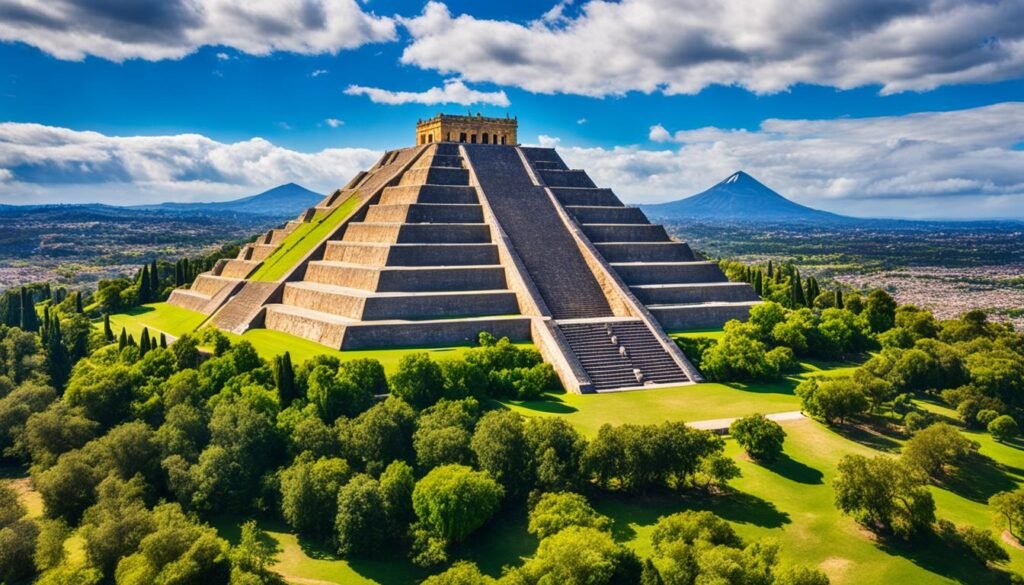
Construction Phases and Architectural Wonders
The Cholula Great Pyramid, also known as the Tlachihualtepetl, is a marvel of ancient architecture. It was built over 2,300 years ago. The pyramid has gone through many construction phases, each adding to its beauty and complexity.
The first phase began around the 3rd century BCE. It started with a core about 10 meters square at the base. This core, called “La Conejera,” became the base for later additions.
From AD 200 to 350, the Pyramid of the Painted Skulls was built. It covered the original core, forming a stepped pyramid with seven levels. At the top was a two-story structure and the Altar of the Sculpted Skulls.
The last major phase was the Pyramid of the Nine Stories. Built between the 6th and 9th centuries CE, it added to the pyramid’s size and complexity. This phase included a radial pyramid with nine stories and a Jaguar Alter.
| Construction Phase | Time Period | Key Features |
|---|---|---|
| La Conejera | c. 200 BCE | Adobe core, 10 meters square at base |
| Pyramid of the Painted Skulls | AD 200-350 | Seven stepped levels, rectangular platform, two-story structure, Altar of the Sculpted Skulls |
| Pyramid of the Nine Stories | AD 600-900 | Radial pyramid, nine-story stairways, Jaguar Alter |
The Cholula Great Pyramid is a stunning example of pre-Columbian architecture. It shows the creativity and adaptability of the Toltec and other ancient cultures. Its size and complexity amaze visitors and scholars, giving us a peek into Mexico’s rich cultural past.
A Shroud of Mystery: Nature’s Protective Veil
In the green fields of Cholula, the Cholula Great Pyramid, a UNESCO World Heritage Site, shows the Aztec influence and Pre-Columbian architecture. This huge monument, once high above the land, is now hidden by nature’s cover.
For years, the pyramid was hidden in sight, fitting right into the hills and greenery around it. This natural cover was key in keeping the ancient site safe. It protected it from invaders and the effects of time.
The grass and trees on the pyramid weren’t just random. They acted as a shield, helping the monument last through the ages. The Spanish thought it was just a hill, but the plants kept the pyramid’s secrets safe. This let the Cholula Great Pyramid survive for centuries.
“The Cholula Great Pyramid is a remarkable example of how nature can serve as a guardian, preserving the vestiges of a bygone era and safeguarding the stories that lie within.”
This disguise had both good and bad sides. It saved the pyramid but also hid its true nature. As we learn more about this ancient site, we see how history and nature work together.
The Cholula Great Pyramid shows how the past can endure. It has survived time and human conflicts, all thanks to the land that surrounds it.
The Convergence of Eras: Church atop History
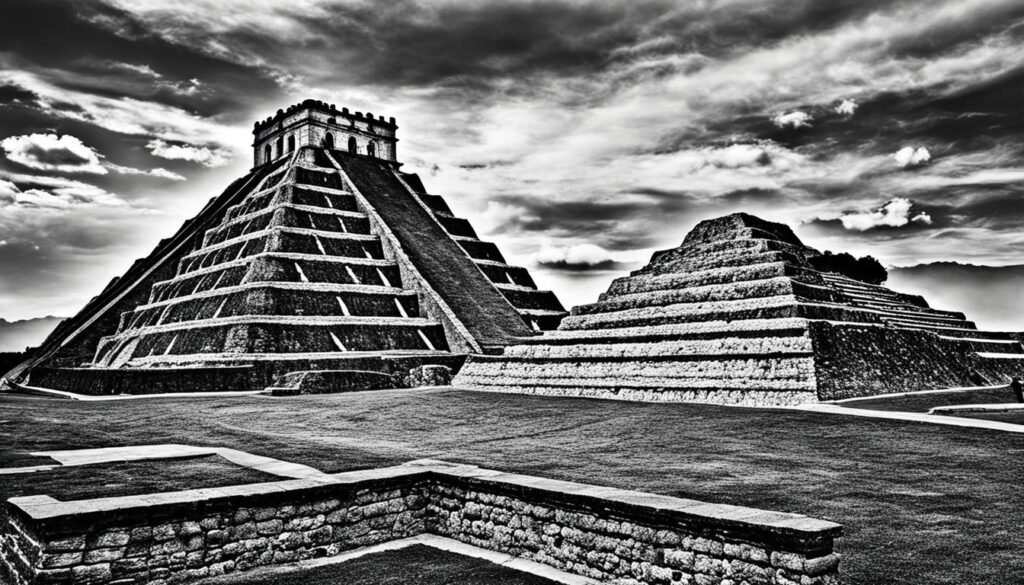
At the top of the Cholula Great Pyramid is a surprising sight — the “Iglesia de Nuestra Señora de los Remedios” church. This church was built by Spanish conquerors in the 16th century. It shows where the old world met the new, blending indigenous heritage with colonial influence.
Colonial Influence and Indigenous Heritage
The church sits on top of the pyramid, showing how conquerors changed sacred places. They replaced ancient Aztec influence with their own beliefs. But the pyramid still stands, showing the strength of indigenous beliefs under colonial rule.
This mix of old and new architecture reminds us of the complex history of the Cholula Great Pyramid. It shows how the past and present mix, creating the culture of today’s Mexico.
“The convergence of the colonial church and the ancient pyramid stands as a testament to the resilience of indigenous heritage and the complex interplay of cultures that has defined the history of this remarkable site.”
Echoes from the Past: Archaeological Discoveries
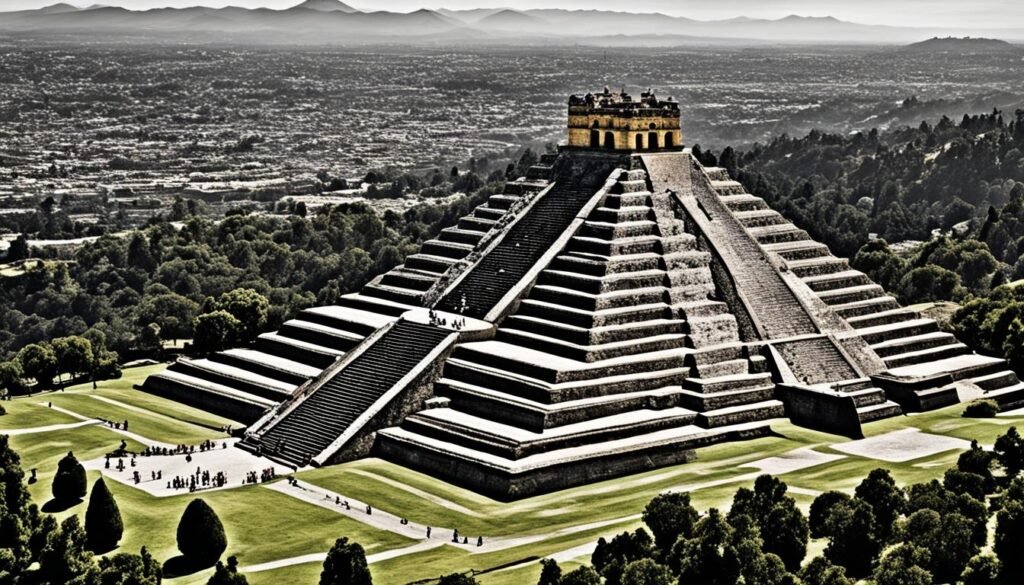
The Cholula Great Pyramid in Mexico is a key piece of history. It shows us the rich cultures of Mesoamerica that once lived there. Through archaeology, we’ve found many artifacts that tell us about their lives and beliefs.
These artifacts include pottery, murals, and detailed items. They give us clues about the Cholula Great Pyramid’s history. This ancient building, from 1700-1100 BCE, still fascinates experts as they uncover its secrets.
- Archaeologists found signs of human sacrifice, like an altar for the Aztec god Quetzalcoatl. This shows us the rituals and beliefs of the people who lived there.
- The pyramid’s design, similar to the Teotihuacan style, shows how Mesoamerican cultures shared ideas. This highlights their common architectural traditions.
- After the 2017 earthquake, the church on top of the pyramid needed repairs. This shows how fragile this historical site is.
The Cholula Great Pyramid is still an unfinished story. It’s a reminder of a history that was interrupted but still intrigues us. With every new find, we hear the whispers of the past. It invites us to dive into the world of Mesoamerican civilization.
“The Cholula Pyramid is a true enigma, a colossal structure that has stood witness to the rise and fall of countless civilizations. Each artifact unearthed is a precious thread in the tapestry of our shared history.”
Exploring Cholula’s Enigmatic Marvel
For those drawn to the Cholula Great Pyramid, a visit is essential. You can join guided tours led by experts. They share fascinating stories and cover the archaeological site thoroughly. Though climbing the pyramid is not allowed for safety, some parts are open for a closer look at this Mesoamerican civilizations treasure.
Tips for Navigating and Experiencing the Site
Getting to Cholula is easy, with flights to Mexico City or Puebla, or buses and private cars. Once there, taxis or rideshares can take you around town and to the pyramid. Here are some tips for a great visit:
- Choose a guided tour for deep insights into the pyramid’s past and importance.
- Wear comfy shoes and clothes for the site’s rough terrain.
- Don’t forget sun protection and water, as it can be hot.
- Plan to spend enough time to fully enjoy the Cholula Great Pyramid and its surroundings.
- Check out the nearby churches and museums for more cultural insights.
Visiting this mysterious site lets you uncover its rich history. It helps you appreciate the legacy of Mesoamerican civilizations in this area.
Conclusion
The Great Pyramid of Cholula is a symbol of ancient Mesoamerican civilizations‘ strength and creativity. For centuries, it was hidden under the jungle. Now, it shows off the amazing pre-Columbian architecture and the deep cultural heritage of the area.
Visitors can see how different groups added to the pyramid over time. It tells the story of the people who lived there, their beliefs, and their daily life. The Great Pyramid of Cholula shows how people’s spirit and culture can last through hard times.
This massive structure is still amazing us with its size and detailed designs. Thanks to archaeologists, we can see its beauty and importance. The Cholula Great Pyramid reminds us of human creativity and the lasting impact of ancient cultures on our world.



